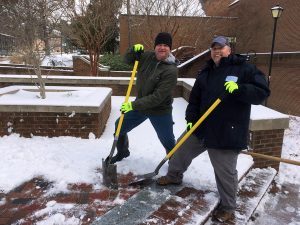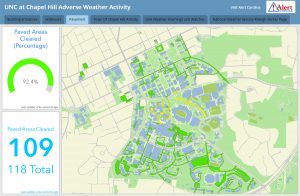Chapel Hill receives an average of seven inches of snow a year, and while most snow or ice events occur in January, Facilities Services begins to prepare for winter weather in September. That’s when the Grounds Services Snow Team, lead this year by Grounds Supervisor Kevin Denardo and Stormwater Supervisor Robert Bradley, begins to establish the Snow Plan for the upcoming season.

A key goal of the Snow Team is to ensure that all equipment needed for an adverse weather response is ready and prepared. The team hooks up and tests plows, brine tanks, tractors, skid steers and other vehicles and equipment to make sure they are in good condition and fully operational. They also check the inventory of shovels, bulk salt and sand, and other supplies to ensure that levels will be sufficient.
Denardo stresses that staff safety is extremely important. Vehicle and equipment operators are provided with maintenance and safety checklists for their equipment, which should be inspected before and after each use. The Snow Team also holds a “Snow Roadeo,” an annual training and demonstration session for staff to review snow procedures, practice hooking up and operating equipment, and to review cold weather work safety tips.

Tom Bythell, campus forest manager, explains the logistics behind clearing a campus of Carolina’s size. For the campus to open, key roads and parking lots, primary and ADA building entrances, and the walkways that connect them all must be cleared and accessible. The strategy is to divide and conquer. “We divide the campus into zones and for each area we have maps, some color-coded by vehicle, that identify exactly where staff should clear.” As part of the snow planning process, staff are pre-assigned to specific zones, equipment and clearing responsibilities, so in the event of snow or ice staff can be dispatched quickly and efficiently. The campus community can see which areas and entrances are marked for priority clearing on the University’s Snow Removal Priority Map.
Twenty-four to 48 hours before snow or ice is forecast to arrive, the Snow Plan is put into action. Grounds staff spread sand and brine and Housekeeping Services pretreats building entrances. All vehicles are fully fueled at the Facilities Service Station and vehicles that may be hard to start in colder temperatures are moved indoors into garage bays. If extremely low temperatures are expected, Energy Management Control Systems staff monitor building and environmental systems to ensure they stay online.

Once precipitation tapers off, Facilities staff report to campus to begin clearing efforts per their assigned zones and priority areas. Grounds Services works to plow streets, parking lots and campus walkways, Building, Construction and Housekeeping Services staff begin clearing and retreating building entrances and ramps, and other departments assist where needed. University Fleet Manager Mark Stark and his staff clear the Service Station so vehicles can refuel but also to prevent accidents. “The last thing you want is for a vehicle to slide into the fuel pumps.”
Second-shift staff are called in to assist so that clearing efforts can continue into the night as well. Some staff stay overnight to keep high priority areas such as UNC Hospitals and the Emergency Room clear and accessible. If students are on campus, maintaining access from residence halls to campus dining halls and Campus Health Services is also a priority.

As crews work across campus, reports on campus conditions and clearing efforts are fed to the Emergency Operations Center (EOC) to support decision making and campus communications. This year the Facilities Technology Group will also be testing a new Adverse Weather Dashboard. As crews report in, clearing locations will be updated and displayed on a campus map in real time, giving management and the EOC an up-to-date and complete overview of campus conditions at any given time.
Depending on University operating needs and weather conditions, 150 to 300 Facilities staff from a number of departments may report to clear campus while many more support behind the scenes. Grounds Services Director Steve Gooch is thankful for the support and assistance. “Grounds may take the lead, but we rely on our partners – it’s a team effort.”
